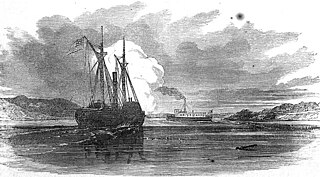
A tugboat or tug is a marine vessel that manoeuvres other vessels by pushing or pulling them, with direct contact or a tow line. These boats typically tug ships in circumstances where they cannot or should not move under their own power, such as in crowded harbors or narrow canals, or cannot move at all, such as barges, disabled ships, log rafts, or oil platforms. Some are ocean-going, and some are icebreakers or salvage tugs. Early models were powered by steam engines, which were later superseded by diesel engines. Many have deluge gun water jets, which help in firefighting, especially in harbours.

The Mary D. Hume was a steamer built at Gold Beach, Oregon in 1881, by R. D. Hume, a pioneer and early businessman in that area. Gold Beach was then called Ellensburg. The Hume had a long career, first hauling goods between Oregon and San Francisco, then as a whaler in Alaska, as a service vessel in the Alaskan cannery trade, then as a tugboat. She was retired in 1977 and returned to Gold Beach. In 1985 she sank in the Rogue River and has remained there ever since as a derelict vessel on the shoreline. The Hume is listed on the National Register of Historic Places.
The Santa Fe Railroad tugboats were used by the Atchison, Topeka and Santa Fe Railway to barge rail cars across the San Francisco Bay for much of the 20th century, as there is no direct rail link to the San Francisco peninsula. In the post World War II period, a fleet of three tugs moved the barges: the Paul P. Hastings, the Edward J. Engel, and the John R. Hayden. After cross-bay float service had ended and the tugs had been sold, the Hastings sank off Point Arena, California in 1992, in water too deep to raise. The Engel sank off Alameda, California in 2007 and was raised and scrapped in the winter of 2013-14. The Hayden remains afloat and in service in Oregon.

Luna is a historic tugboat normally berthed in Boston Harbor, Massachusetts. Luna was designed in 1930 by John G. Alden and built by M.M. Davis and Bethlehem Steel. She is listed on the National Register of Historic Places and is a U.S. National Historic Landmark. In 1985, the Luna was designated as a Boston Landmark by the Boston Landmarks Commission.

Baltimore is a preserved steam-powered tugboat, built in 1906 by the Skinner Shipbuilding Company of Baltimore, Maryland. She is formerly the oldest operating steam tugboat in the United States, but at present does not hold an operating license issued by the US Coast Guard, so is unable to leave her dock at the Baltimore Museum of Industry on Key Highway, Baltimore. Her hull is not capable of operating on open water. Baltimore was built and operated as a harbor inspection tug, capable of acting as a municipal tugboat for city barges, as well as an official welcoming vessel and VIP launch, an auxiliary fireboat, and as a light icebreaker.
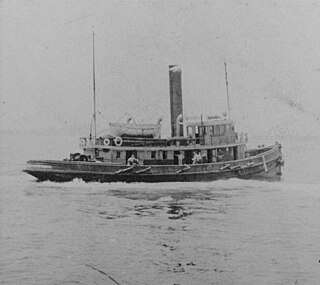
Bouker No. 2, originally Robert Rogers, was a tugboat built in 1904 for merchant service in and around the waters of New York City. During World War I, the tug was commissioned into the United States Navy as USS Bouker No. 2 (SP-1275), and continued in naval service until 1921. Briefly considered for service as a fireboat in Norfolk, Virginia, she was instead returned to merchant service in 1922 as a tugboat, under the name New York Marine Co. No. 6. She was sunk in collision with a passenger steamer in 1926.

USNS Powhatan (T-ATF-166) was the lead ship of the United States Navy Powhatan-class fleet ocean tugboats. She was in service with the U.S. Navy from 1979 to 1999, and then was leased to a private towing and salvage company. At the end of the lease in 2008, the ship was sold to the Turkish Navy which recommissioned her as TCG Inebolu.
Herakles was a pusher vessel owned by Finnish towing and marine salvage company Alfons Håkans Oy Ab. The ship, originally built as salvage tug Into in 1967, was converted to a pusher in 1991 to be chartered to Rautaruukki Oyj and later ESL Shipping Ltd as the third pusher vessel for the Finnpusku system, a Finnish integrated tug and barge system built in the mid-80s.

Urger, originally named H.J. Dornbos or Henry J. Dornbos, is a historic canal tugboat based at Waterford in Saratoga County, New York.

Mayflower is a steam tug built in Bristol in 1861 and now preserved by Bristol Museums Galleries & Archives. She is based in Bristol Harbour at M Shed. She is the oldest Bristol-built ship afloat, and is believed to be the oldest surviving tug in the world.

The Gwendoline Steers was a tugboat owned by the Steers Sand & Gravel Company of New York, NY. It sank in an ice storm in Long Island Sound approaching the mouth of Huntington Bay, New York on December 30, 1962, with the loss of the entire crew of nine.
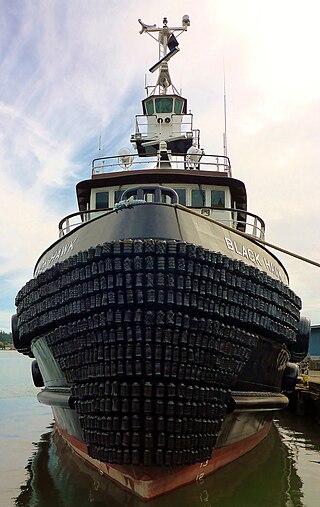
Sause Bros., Inc., a pioneering Oregon ocean towing company founded in 1936, is a privately held, fourth-generation family company serving routes along the West Coast of the United States, Hawaii and other islands of the South Pacific, as well as Alaska. It maintains a sixty-vessel fleet of tugboats and barges, employing approximately 400 people at its facilities in Coos Bay, Portland, and Rainier, Oregon; in Long Beach, California; and in Honolulu and Kalaeloa, Hawaii.

C.H. Wheeler was a schooner-rigged unpowered lumber barge that operated during the year 1901, making only a few voyages before it was wrecked near Yaquina Bay with the loss of one life. C.H. Wheeler was the largest vessel up to that time to reach Tillamook City and the first vessel to transport a load of lumber from Tillamook to San Francisco. The circumstances of the loss of the C.H. Wheeler were controversial and resulted in the arrest of the captain of the tug that had been towing the barge before it was wrecked.

The Type V ship is a United States Maritime Commission (MARCOM) designation for World War II tugboats. Type V was used in World War II, Korean War, and the Vietnam War. Type V ships were used to move ships and barges. Type V tugboats were made of either steel or wood hulls. There were four types of tugboats ordered for World War II. The largest type V design was the sea worthy 186-foot (57 m) long steel hull, V4-M-A1. The V4-M-A1 design was used by a number of manufacturers; a total of 49 were built. A smaller steel hull tugboat was the 94-foot (29 m) V2-ME-A1; 26 were built. The largest wooden hull was the 148-foot (45 m) V3-S-AH2, of which 14 were built. The smaller wooden hull was the 58-foot (18 m) V2-M-AL1, which 35 were built. Most V2-M-AL1 tugboats were sent to the United Kingdom for the war efforts under the lend-lease act. The Type V tugs served across the globe during World War II including: Pacific War, European theatre, and in the United States. SS Farallon, and other Type V tugs, were used to help built Normandy ports, including Mulberry harbour, on D-Day, 6 June 1944, and made nine round trips to Normandy to deliver Phoenix breakwaters.

SS Robert Wallace was a wooden-hulled American bulk freighter that served on the Great Lakes of North America from her construction in 1882 to her sinking in 1902 on Lake Superior near the town of Palmers, St. Louis County, Minnesota, United States. On November 17, 1902 shortly after leaving Superior, Wisconsin with a cargo of iron ore, Robert Wallace sprang a leak and sank. Her wreck was found in 2006, and on October 14, 2009, the wreck of Robert Wallace was listed in the National Register of Historic Places.

The SS Lakeland was an early steel-hulled Great Lakes freighter that sank on December 3, 1924, into 205 feet (62 m) of water on Lake Michigan near Sturgeon Bay, Door County, Wisconsin, United States, after she sprang a leak. On July 7, 2015, the wreck of the Lakeland was added to the National Register of Historic Places.

The Amboy was a wooden schooner barge that sank along with her towing steamer, the George Spencer on Lake Superior off the coast of Schroeder, Cook County, Minnesota in the United States. In 1994 the remains of the Amboy were added to the National Register of Historic Places.
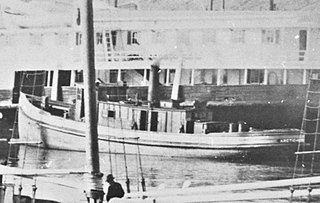
The Arctic was a wooden hulled tugboat that worked on the Great Lakes of North America from 1881 to 1930. In 1930 the Arctic was stripped of her machinery, and abandoned at Manitowoc, Wisconsin. On June 22, 2018, the remains of the Arctic were listed on the National Register of Historic Places.

SS Selah Chamberlain was a wooden-hulled Great Lakes freighter that sank in Lake Michigan in 1886, 6 miles (10 km) off the coast of Sheboygan, Sheboygan County, Wisconsin, United States after being rammed by the steamer John Pridgeon Jr. with the loss of five lives. On January 7, 2019, the wreck of Selah Chamberlain was listed on the National Register of Historic Places, and was given the reference number 100003288. She was the first shipwreck listed on the National Register of Historic Places in 2019.
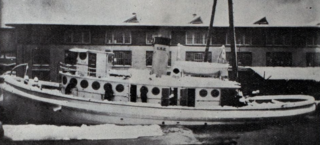
Essayons was a tugboat of the United States Army Corps of Engineers. Her mission with the Corps was to support the installation of breakwaters and piers, and the dredging of harbors on Lake Superior. She was built in 1908 and served with the Army until 1949, when she was sold to the Zenith Dredge Company. Essayons continued her support of port construction and maintenance under her new owner until the mid 1960s. In 1994 she was sold again, this time to a local businessman, who hoped to convert her into a floating Bed and Breakfast. This plan never came to fruition and she sank at her moorings in Duluth Harbor in 2009.


















